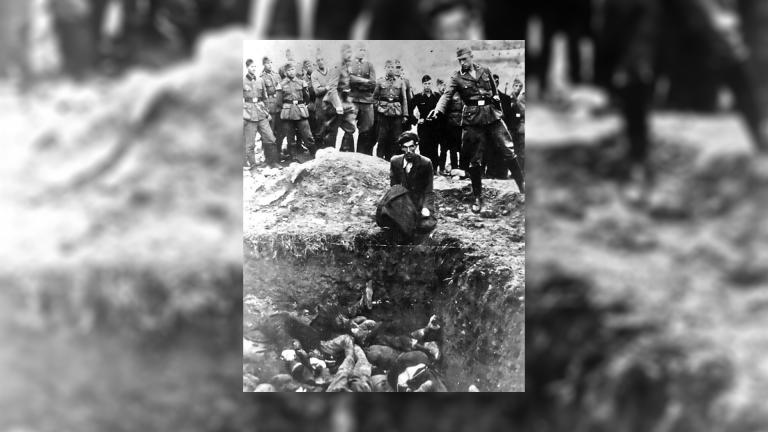
Read more about WW2

For decades, a single photograph has haunted Holocaust history. It shows a uniformed Nazi soldier pointing a pistol at the head of a kneeling Jewish man beside a mass grave. It has become one of the most recognisable – and disturbing – visual records of the Holocaust.
Long captioned as The Last Jew in Vinnitsa, the photograph was believed to show the final moments of an unidentified victim in the Ukrainian city of Vinnytsia in 1941. But recent research has revealed far more than was previously understood – including the likely identity of the executioner.
As Sky HISTORY has been finding out, it’s all been made possible through a combination of detective work, open-source research and artificial intelligence.
For years, historians struggled to trace the photo’s origins. It circulated in 1961 during the trial of Adolf Eichmann, after the United Press received it from a Polish Jew who had been liberated from the Allach concentration camp.
Over the following decades, it was frequently used in exhibitions and textbooks, stripped of its original context, as a stark representation of the horrors of the Holocaust.
But Dr Jurgen Matthäus, a German-born historian at the United States Holocaust Memorial Museum, wasn’t satisfied with the assumptions about the image. Working with open-source investigators, including researchers associated with Bellingcat, he began a years-long effort to locate where – and by whom – the killing actually took place.
Through archival cross-referencing, troop records and visual analysis, the team determined that the massacre didn’t happen in Vinnytsia at all. Instead, the scene was traced to Berdychiv, another city that suffered devastating losses under Nazi occupation.
The breakthrough came when historians used artificial intelligence facial-matching tools to compare the gunman’s face with photographs of known Nazi personnel stationed in the region at the time.
After Matthäus had published his initial findings about the location of the shooting, a reader got in touch, believing that the soldier in the photo could be his wife’s uncle, Jakobus Onnen.
Relatives had long since destroyed letters from Onnen, but still had photos of him that they could supply for AI image analysis. The analysis was clear – it pointed to a strong match.
'The match, from everything I hear from the technical experts, is unusually high in terms of the percentage the algorithm throws out here,' Matthäus says, before adding that working with historical photos makes it hard to arrive at a 98 or 99% match.
But the strong results, combined with mountains of circumstantial evidence, gave credence to the findings.
However, Matthäus still stresses the importance of the human factor in research like this. “This is clearly not the silver bullet – this is one tool among many. The human factor remains key.”
While the identification of Onnen may answer one long-standing mystery, another remains unresolved: who was the man on his knees?
Tragically, the victim’s name is still unknown, like millions of others murdered in the Holocaust’s mass shootings across Eastern Europe. But Matthäus’ project continues and hopes to uncover the victim’s identity. Alongside a Ukrainian colleague, they continue to examine Soviet-era records of local communities like Berdychiv.
They believe that AI can be used in this vital detective work, if comparable images of the kneeling man can be found.
For Matthäus, each new discovery is not just about sensational revelation, but about remembrance.
'There were more than one million victims in the occupied Soviet Union,' he says. 'Most of them are unknown, just as the killers intended.'
The unmasking of the Nazi in one of the Holocaust’s most infamous images stands as a haunting reminder of how memory, evidence and technology intersect.
It also provides hope that the names of the Holocaust’s forgotten victims will one day be remembered and their stories shared. Artificial intelligence may not rewrite history, but it is helping historians fill its gaps – one photograph, one face, one name at a time.
Richard Bevan is an MA Screenwriter/playwright who has written for television, radio and stage. He specialises in history and true crime writing.
In this astounding article Sky HISTORY shows how tenacious researchers, open source data, and artificial intelligence came together to expose the perpetrator of a brutal crime over 80 years after it was perpetrated.
Recently, AI has shown itself able to be more productive in business, better at identifying malignant tumours in X-rays, and now… instrumental in revealing Nazis.
In the hands of historians, researchers, and journalists this technology could be invaluable combing through former Eastern German Statsi files, Libyan secret police documents, and DNA results from mass graves throughout the years in Slovenia, Iraq, and Spain and beyond. It can be a true boon in accountability and justice.
In the hands of more nefarious actors (and governments), this same technology can be used to distort history by manipulating images, planting data, and fabricating evidence.
This is why trusted information sources like Sky HISTORY are so important. In the coming age where politicians cry 'fake news' the questions we will have to ask will be 'Is that an accusation or a confession?' Is that the face of a serial killer, or the leader of the opposition?
Want more fascinating stories like this? Sign up to the Sky HISTORY newsletter today! Every week, you’ll receive fascinating history stories, news, clips and more delivered straight to your inbox.